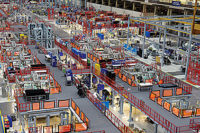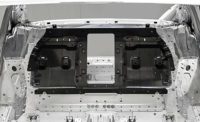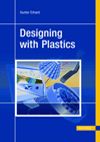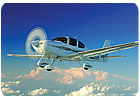
Most boys build plastic airplane models at some stage of their young lives. In fact, for many kids, it’s their first exposure to the assembly process.
One of the key steps in building a model plane involves gluing the right and left half of the fuselage together. A pair of Midwestern brothers, Alan and Dale Klapmeier, have never forgotten that experience. Nor have they outgrown it. They’ve taken the concept and applied it to the way single-engine aircraft are mass-produced.
The Klapmeiers and their company, Cirrus Design Corp. (Duluth, MN), have revolutionized the general aviation industry. The company uses composite materials to build a popular four-seat, 310-hp aircraft called the SR22. It also markets SRV and SR20 models, which have smaller engines than the top-of-the-line SR22. In addition, Cirrus currently is engineering the SRS, which is a sporty, two-seat derivative.
A key feature of all the Cirrus aircraft is their all-composite construction. Fuselages, wings and other components are molded in fiberglass, which allows for a smooth, curvy exterior without the rivet lines found on traditional aluminum airframes.
“Composites offer many advantages to other materials used in manufacturing,” says Lynx Johnson, director of composite assembly. “They are extremely flexible. You can create complex and seamless shapes compared to limitations offered by metals.
“We are able to manufacture complex part shapes utilizing fiberglass, carbon and closed cell core material, which can be formed by heating,” explains Johnson.
“In noncomposite designs, the same process will utilize multiple parts mechanically fastened together, which adds time and weight to the aircraft. [Composites] offer us the ability to limit part manufacturing, improve flow and limit assembly steps in our production.”
Composite airframes are also easier to maintain and repair than aluminum. “Cost and durability are great aspects to the use of composites,” says Tom Haggy, director of composite production. “The composite parts are strong, durable and, in many cases, repairable with methods which [in most instances] are done in the field.”
In addition to composite airframe structures, the sleek Cirrus planes sport two innovative features that make them appealing to owners: A parachute and a glass cockpit. According to Tom Bartoe, executive vice president of manufacturing, first-time plane owners account for almost 30 percent of Cirrus sales, because the company’s products have a reputation for being safe and easy to fly. “Every design has been made with pilot safety, comfort and ease-of-operation in mind,” he points out.
Cirrus pioneered the unique concept of a plane with a parachute. The Cirrus Airframe Parachute System (CAPS) is a standard feature on all aircraft the company builds. A cavity in the roof of the plane holds a ballistic parachute that is deployed with a rocket in the event of a catastrophic incident, such as a midair collision.
The 2,400-square-foot parachute is attached to the plane via heavy-duty Kevlar harnesses that are bonded into the fuselage. Since the first CAPS deployment 5 years ago, the device has been credited with saving the lives of 25 Cirrus pilots and passengers.
Another key feature is the glass cockpit. All Cirrus planes use a curved instrument panel that’s modeled on a car dashboard. Instead of the traditional smorgasbord of analog instruments, dials and gauges that can be intimidating and difficult to read, each aircraft is equipped with two 10-inch computer monitors.
Most recently, Cirrus took it one step further. It now offers Garmin-based 12-inch screens and keypads instead of dials. The screens feature vivid graphics that display critical information, such as speed, direction and altitude, in addition to weather, terrain and air traffic. Synthetic vision and “highway-in-the-sky” technology has also been added as additional options for the Cirrus pilot.

Cirrus Design assembles more than 75 aircraft per month.
A Growing Market
Cirrus is one of the fastest-growing companies in the general aviation industry. In fact, it has been manufacturing the world’s best-selling aircraft, the SR22, for the last 6 years. In 2007, Cirrus delivered 703 new aircraft. Currently, four aircraft per day are completed.“There has not been another start-up airplane manufacturing company in the last 50 years to accomplish what Cirrus has,” claims Alan Klapmeier, chairman and CEO. “[We] have done what no other aviation company has done since World War II, by producing 3,000 airplanes within the first 7 years of its original delivery. The SR22 has become the best-selling airplane on earth. Since [we delivered our first aircraft] nine years ago, we have rejuvenated a sagging general aviation industry.”
General aviation is defined as all aviation other than scheduled commercial airlines and military aircraft. According to the General Aviation Manufacturers Association (GAMA, Washington, DC), 166 million passengers fly on general aviation aircraft, such as single-engine piston airplanes, helicopters, turboprops and business jets, annually in the United States. Nearly 70 percent of the hours flown by general aviation are for business purposes.
Aircraft demand is increasing. For instance, GAMA claims that the market for general aviation airplanes rose to an all-time high in 2006-a 24 percent increase over 2005. Last year, sales rose 17 percent.
“We are seeing the influence of industry innovation and the effects of accelerated depreciation,” says Pete Bunce, president of GAMA. “All segments of the industry are pointing up, which is generating optimism for a continuation of the industry’s recovery.
“More and more corporations are taking advantage of the efficiencies of private travel in business turbine aircraft and we are seeing a similar trend in the piston market, where company employees are choosing to fly themselves to their business destination,” adds Bunce. “We are also seeing the influence of safety-enhancing advanced avionics becoming standard equipment on more and more piston airplanes.”
The National Aeronautics and Space Administration (NASA, Washington, DC) has been pushing for a revolutionary air traffic management concept dubbed the “highway in the sky,” which could spur additional demand for personal aircraft such as the Cirrus SR22. By harnessing advanced GPS and computer technology, it is expected to make general aviation easier and safer.
NASA officials recently demonstrated a Small Aircraft Transportation System (SATS), which is a point-to-point travel scheme that uses high-tech guidance tools. It aims to enable travelers to sidestep the overburdened system of hub-and-spoke airports in favor of thousands of tiny airstrips that dot the United States.
According to the National Consortium for Aviation Mobility (Hampton, VA), SATS could relieve congestion at major airports, such as Chicago’s O’Hare Field, by as much as 10 percent. By using collision-avoidance systems and head-up displays, SATS would make small airports much more accessible in all types of weather conditions.
Growing demand for air taxi service is also expected to transform the general aviation market. Joe Leader, president of the Air Taxi Association (Atlanta), says the goal is to provide personal air travel at commercial airline prices. He claims it represents “the next evolution in air travel. This is about getting people off crowded roadways and into our open skies on direct flights.”
“The air taxi concept has been successful because people sense there’s a high ratio of value to cost,” says Steve Hanvey, CEO of Smart Air Travel Solutions Air (SATSair, Greenville, SC), which serves customers in the Southeast and operates a fleet of Cirrus SR22 aircraft. “Utilizing the piston single-engine airplane in such a manner is an industry-changing event. We are introducing a new segment of the population to the tremendous lifestyle advantages that can only be obtained through personal aviation.”

Composites allow Cirrus to limit part manufacturing, improve flow and eliminate assembly steps.
Dressing in Layers
Building a Cirrus plane involves three key production processes: lay up, bonding and assembly. Each aircraft consists of 120 composite parts, which are made in a 170,000-square-foot plant in Grand Forks, ND. Parts are then shipped by truck to the final assembly line in Duluth, which is 260 miles away.The company produces approximately 400 parts per day, which is the equivalent of 3.3 aircraft. “But, we are averaging more than 8,000 parts per month at our current rates,” Haggy points out.
The fuselage skins take the longest to make. Each requires more than 6 hours, because of the size and complexity of the parts. “Many layers of fiberglass prepreg go into building each part, and managing these builds has been a focal point of our business for over 10 years,” says Haggy.
For instance, the fuselage skin comprises more than 30 layers of glass at the thickest point and weighs about 65 pounds when complete. “At one time, the fuselage took more than 119 hours to produce,” explains Haggy. “With the application of lean concepts, we complete these builds in under 24 hours.”
The prepregnated fiberglass comes in sheets that are laid out on a large table. A computer-controlled ply cutter creates a variety of large and small sheets that conform to the size and dimensions of each part.
A team of operators then lay the pieces into molds. Once lay up is complete, vacuum pressure is applied to the mold to remove excess air. After bagging, each mold is placed inside huge ovens where they are cooked at high temperatures and various times, depending on the size and complexity of the part.
Molds were once made out of fiberglass, which was cost-effective and easy to change. But, Cirrus is using more steel molds because they are more robust.
“Fiberglass molds with a high-temperature gel coat have been used when making tooling that has a higher probability to engineering changes,” says Haggy. “As we move forward, we have been working more and more with steel tooling for our molds. Its expansion coefficient and ability to be machined and repaired, as well as it durability, has been a winning mix for our production environment. We are also working with some higher temperature prepreg molding materials that have a higher surface finish and tend to be more robust than the older gel coat-style molds.”
According to Haggy, the biggest challenge to making composite parts is environmental control of the shop environment. “Our current system manages the environment within 1 to 2 points for humidity and a degree on temperature,” he explains.
The success of the Grand Forks plant has attracted the attention of larger aerospace manufacturers. For instance, engineers from Boeing’s Winnipeg, MB, plant, which is located 140 miles north, studied composite production techniques at Cirrus when they were developing the company’s new 787 jetliner.

After the two fuselage sides are bonded together, they start to resemble an airplane.
Building Composite Parts
After the composite parts arrive at the 200,000-square-foot Cirrus plant in Duluth, operators begin the process of joining all the pieces together. One of the biggest challenges of composite manufacturing lies in the ability to coordinate curing schedules around the assembly process.“A lot of things can be improved through design, tooling and lean practices, but the curing is a constant,” says Johnson. “We’ve overcome this hurdle by utilizing initial cures, which obtain handling strength in less time, and by strategically placing work in process.”
The final curing step, or post-cure, requires a longer duration at a higher temperature. “This is a critical part of the process to obtain the final strength and glass transition temperature of the resin and adhesive,” explains Johnson. “We use a range of two-part epoxy adhesives, depending on the application.”
Cirrus relies on a proprietary structural adhesive blend. “We have alternate adhesives for secondary structures, which give greater flexibility in curing and application,” says Johnson. “We also use flexible epoxy or polysulfide adhesives and sealants for fuel bays and limited aluminum-to-fiberglass bonding.”
Curing, and especially post-curing, is the longest cycle time in the composite production process. “The most efficient way to cure the fuselage and wing is in a very large air-circulating oven,” notes Johnson.
“With advances in tooling, we moved from a 17-step process to an eight-step process with nine less people in one-half the time,” adds Johnson. “We are also able to perform assembly steps earlier in the build cycle due to the tolerances we are holding.”
Cirrus engineers have developed a wide variety of fixtures and jigs that save time and improve efficiency. “We try to keep our fixtures as simple as possible with a limited number of articulating parts,” says Johnson. “Adhesives and resins have a way of migrating onto fixtures, and conscientious tooling design helps to prevent this.
“We have a core competency for tool and jig manufacturing,” adds Johnson. “Some tooling is composite-based, metal-based or a metal-and-composite combination. All of our tooling is successful because of the joint design efforts of our engineering and tooling departments. They work together from conception and ensure design for manufacturing practices are followed.”
Cirrus uses third-party companies to help design and manufacture larger fixtures. For instance, it has worked with a company that has experience in both the high-volume auto industry and low-volume fighter aircraft manufacturing.
“The new tooling continues to give us tighter tolerances and improved durability,” says Johnson. “Increasing our build cycle is becoming easier and easier with our tooling advances.”
Cirrus engineers use a large clamshell fixture to assemble each fuselage. The five main components-left fuselage panel, right fuselage panel, floor boards, beveled firewall and empennage structure-are loaded into the fixture upside down and then aligned.
Dust and other particles are removed before operators manually apply adhesive. Panels are placed over window and door openings to allow heat to circulate throughout the airframe during the curing stage. The completed fuselage weighs 270 pounds.
“The wing structural assembly is much more complicated than the fuselage, due to the amount of systems and parts involved,” says Johnson. “There are 18 stations in our wing line. These areas are broken up into six cells of which two are primary bonding and two composite finishing (trim and penetrations) and various assembly stations. Fuel tanks, navigational lights, control system hardware wiring and other items are added. The wing is 100 percent complete when it leaves our final cell.”
Once the entire wingspan is assembled, operators attach it to landing gear and the fuselage is lowered into place. However, the wing is attached to the fuselage with metal hardware. The wing assembly is mechanically fastened with hardware vs. bonding to make ongoing airworthiness and field service, including repair, easier.
The final assembly line consists of 12 stations, which are supported by several subassembly workcells. Wire harness installation and firewall buildup is the first step in the process. The last step is interior installation, followed by flight testing.
All aircraft require 3 to 10 hours of testing. However, the harsh winter weather in Duluth can sometimes make the company’s goal of 98 percent on-time delivery quite challenging.
Some aircraft components are outsourced, such as wire harnesses, seats, engines, landing gear and the parachute system. “We work closely with all vendors to establish parts that are ready to install, eliminating the need for additional assembly when received,” says Jerry Heizler, director of the finish center. “Total assembly time is approximately 18 days, which involves 55 line positions including composite bonding.”
Installing the parachute system makes the Cirrus assembly line different from other aircraft factories. It is installed at the end of the final assembly line, prior to the paint station. Heizler says it takes approximately 3 hours to install the system, which includes a pull cable and the parachute itself.
“This time does not include installation of the bonded support bucket and attach straps, which are placed in the skins as part of the composite build process,” notes Heizler. “The assembly process has some special requirements that include explosive handling, storage, specialized training and testing.” The propulsion unit goes in last, so there’s no chance of accidental deployment during assembly.
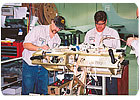
Operators install wire harnesses used in the instrument panel.
Lean Manufacturing Success
Several years ago, Cirrus introduced lean manufacturing principles to aircraft production. “While lean manufacturing has become an often-repeated phrase, Cirrus has been able to truly embrace these principles,” says Bartoe.So far, the efforts have helped streamline operations at both the Duluth and Grand Forks plants. “The use of lean applications to reduce production time has been a key factor in our ability to reduce costs, as well as control [the use of] consumables, scrap and overtime,” says Haggy. “For instance, we integrated ply-cutting technology with a faster drive system.
“In addition, we added a five-axis milling machine for our core laminate production parts,” adds Haggy. “Future operations will incorporate robotic trimming of parts, possible in-place curing, and laser placement for prepreg plies going into the molds to manufacture the parts.”
Since implementing lean manufacturing principles, the final assembly line is always changing due to continuous improvement efforts. “We focus on waste removal and have a very quick response to make any needed changes,” says Heizler. “As we increase our daily production rate, the assembly line will see additional changes in layout that allow for improved flow.
“Focusing on cellular manufacturing, just-in-time part build, and plug-and-play thinking has allowed us to achieve a 2.5-hour takt time,” Heizler points out. “By eliminating waste, we have moved many time-consuming processes upstream, which help reduce final assembly time. We have seen huge gains in reducing consumable costs, process times and throughput.”
One of the greatest efforts has been in driving down ownership of the business to all levels. For instance, all operators are cross-trained so they can perform several different assembly tasks.
“We have some of the best technicians in the world,” claims Heizler. “They can tell you what there defect rate is, how much a gram of resin costs and what the average cycle time is for the day. Having them know the metrics and own the business drives a higher attention to detail and enables continuous change.” That kind of team effort should keep Cirrus flying high for a long time to come. A

Cirrus believes there is a growing market for a "personal jet" that features a single engine.
A Jet-Powered Future?
Engineers at Cirrus Design Corp. (Duluth, MN) have developed a new type of jet-powered aircraft that promises to be easy to operate and low-cost. Alan Klapmeier, chairman and CEO of Cirrus, believes that there is a growing market for a “personal jet ” that features a single engine.Cirrus recently unveiled the Vision SJ50. It features a unique v-tail and an angled backpack-mounted turbine engine manufactured by Williams International Co. (Walled Lake, MI). The composite airframe accommodates up to seven passengers in a pressurized cabin.
“We’re calling it a personal jet, not because of its size but because it’s a natural extension of our SR22 line,” says Klapmeier. “Like the SR22, the jet is designed to be owner-flown and it will be loaded with innovative features, including the airframe parachute system.”
According to Klapmeier, this emerging class of personal jet is somewhere between high-performance piston single-engine flight and a new fast-growing market sector known as very light jets. He claims that this new mode of transportation will complement the very light jet class and will follow his company’s philosophy to grow the personal aviation industry.
“The jet cruises below airline flight levels and offers easy and convenient access to thousands of local airports not served by airline operations,” Klapmeier points out.”
Cirrus expects to ramp up production by 2011. All composite parts will be made at the company’s facility in Grand Forks, ND, while the components will be assembled on a dedicated assembly line in Duluth. However, final assembly may take place on one flexible line that would be used for both the jet and traditional piston aircraft.

